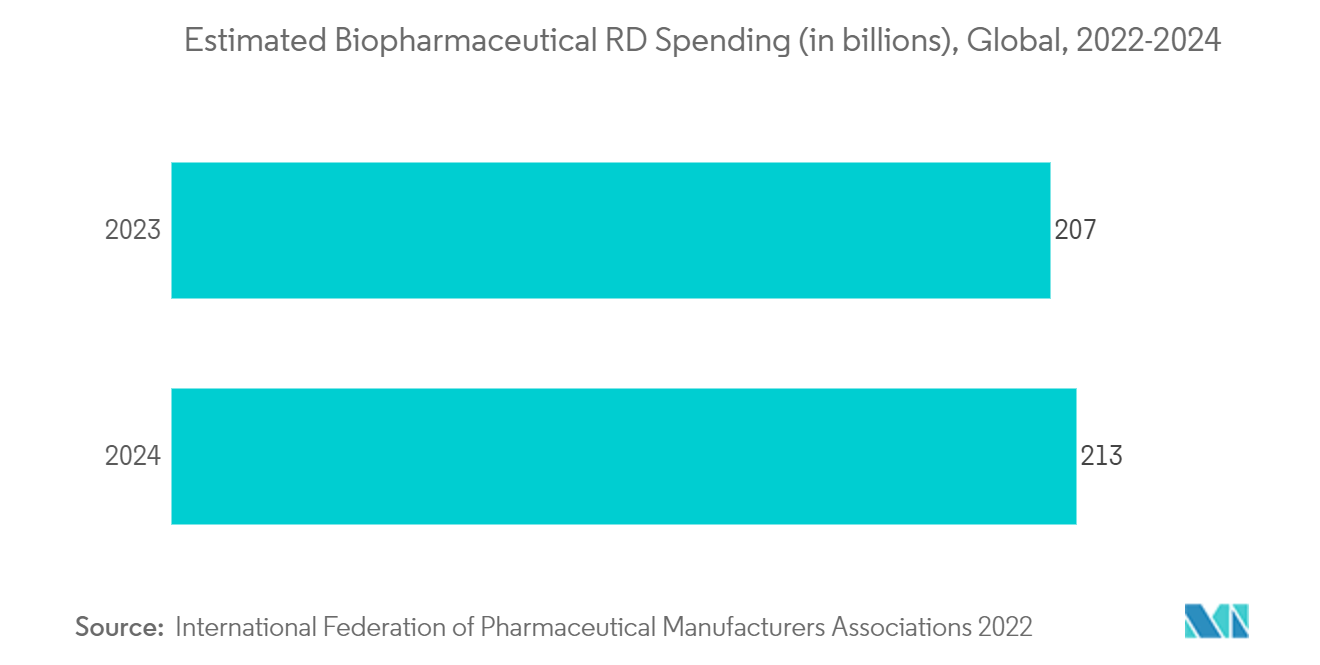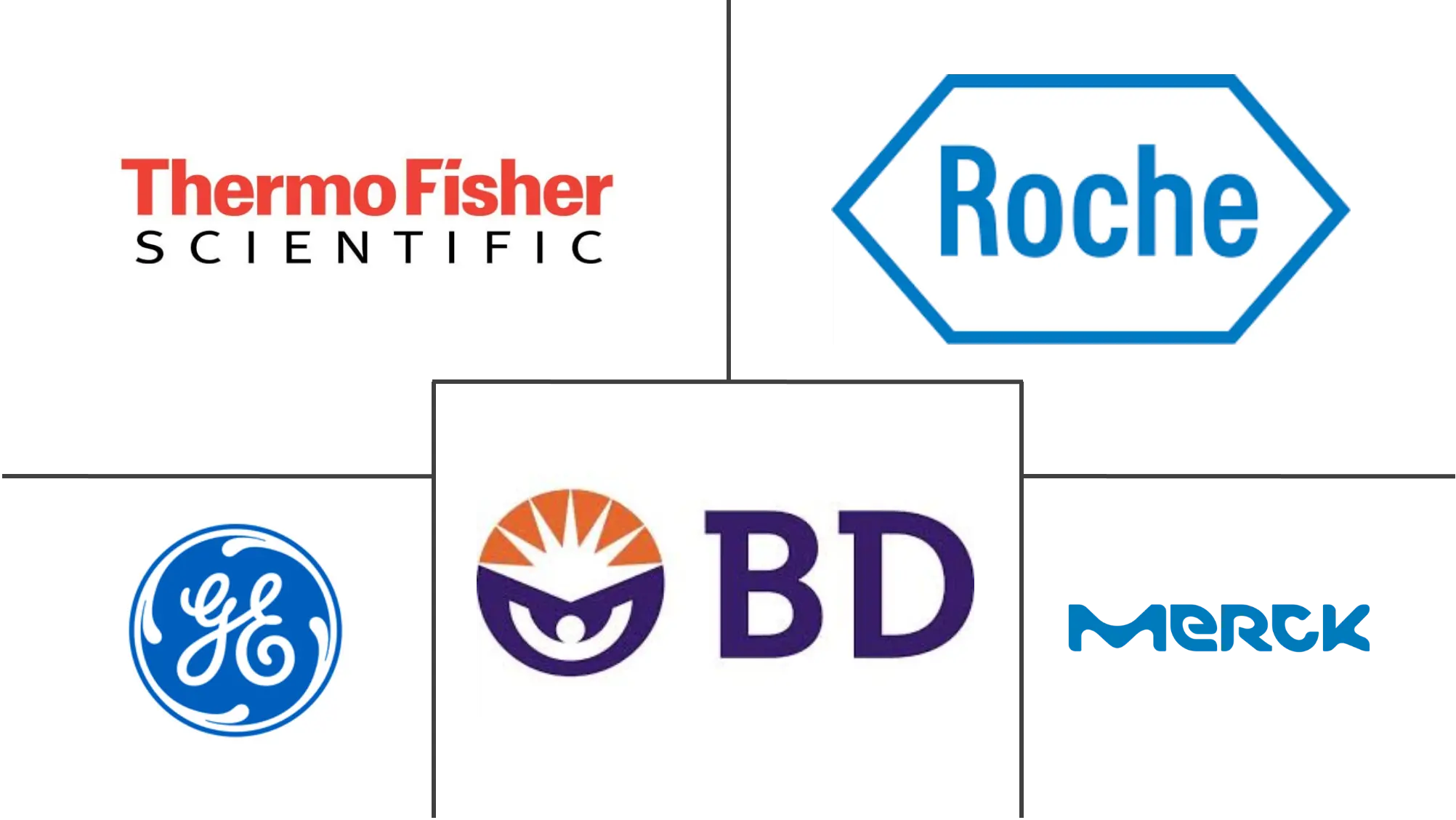
Cell Dissociation Market Analysis
The Cell Dissociation Market size is estimated at USD 0.61 billion in 2025, and is expected to reach USD 1.24 billion by 2030, at a CAGR of 15.17% during the forecast period (2025-2030).
Key drivers fueling market growth include increasing R&D initiatives in biopharmaceutical firms and a global uptick in cancer research funding.
The surge in R&D outlays within the biopharmaceutical sector has been a linchpin in the market's expansion. According to the European Federation of Pharmaceutical Industries and Associations' 2024 report, European pharmaceutical entities allocated EUR 47.01 billion (USD 49.43 billion) in 2022, which was expected to increase to EUR 50 billion (USD 54.11 billion) in 2023.
Several firms are channeling investments into biopharmaceutical R&D. In September 2022, Marinus Pharmaceuticals secured a significant contract option from the Biomedical Advanced Research and Development Authority (BARDA) worth around USD 12.3 million. This move aimed to bolster the manufacturing capabilities of ganaxolone.
Major market players are ramping up their investments in biologics R&D, intensifying the quest for novel biologics. In September 2022, Novartis delved into next-gen biotherapeutics, fortifying its biologics manufacturing and development arm. With such robust R&D commitments, the market is poised for substantial growth in the near future.
Product launches by market players are also pivotal in driving market expansion. For instance, in February 2023, LevitasBio Inc. rolled out its LeviSelect cell depletion and enrichment kits tailored for immunology research.
The market's growth trajectory, bolstered by escalating R&D investments and new product launches, is promising. However, the market may face a hurdle in the form of the high costs associated with tissue- and cell-based procedures.
Cell Dissociation Market Trends
The Pharmaceutical and Biotechnology Companies Segment is Expected to Witness Healthy Growth Over the Forecast Period
Biopharmaceutical companies are intensifying their focus on new drug development and ramping up R&D efforts, consequently driving up the demand for cell dissociation products.
An article from PubMed, released in March 2022, highlighted a surge in the demand for biopharmaceuticals. This surge catalyzed the rise of a new business model, the 'contract development manufacturing organization (CDMO),' designed to streamline biopharmaceutical development and production. CDMOs, equipped to handle larger production volumes, are adeptly meeting the industry's escalating demands.
As pharmaceutical and biopharmaceutical companies increasingly pivot toward cell-related therapies, their strategic R&D investments further fuel the demand for cell dissociation products, bolstering market growth.
In January 2024, AbbVie and Umoja Biopharma inked exclusive licensing deals to advance multiple in-situ generated CAR-T cell therapy candidates in oncology, leveraging Umoja's proprietary VivoVecTM platform.
In December 2023, Fujifilm made a substantial USD 200 million investment in cell therapy manufacturing. The fund was specifically allocated to a drug research segment that is expected to record significant growth in the years ahead. Such strategic moves by market players are pivotal in propelling the market's expansion.
Given the heightened R&D focus of pharmaceutical and biopharmaceutical entities, coupled with the surging demand for cell therapies, the pharmaceutical and biotechnology companies segment is poised for substantial growth in the coming years.

North America is Expected to Hold a Significant Market Share
The North American cell dissociation market is poised for significant growth, driven by the region's advanced biopharmaceutical industry, facilitating robust R&D for novel therapeutics. Heightened company investments in new therapies further bolster this trajectory.
Highlighted in the Cancer Facts & Figures 2024 report by the American Cancer Society, the US is projected to see around 2.0 million new cancer cases in 2024. This, coupled with a rising geriatric population and a surge in chronic diseases, particularly cancer, cardiovascular diseases (CVDs), and diabetes, underscores the nation's growing need for biopharmaceuticals, which is expected to boost market growth.
According to the Canadian Cancer Statistics 2023, unveiled in November 2023, around 239.1 thousand Canadians were expected to undergo a cancer diagnosis in 2023, further emphasizing the demand for innovative therapies and the resultant market growth.
The uptick in biopharmaceutical and cell therapy manufacturing facilities in North America is amplifying the need for cell dissociation products in various research and manufacturing processes. REPROCELL inaugurated a GMP Manufacturing Facility for Stem Cells in the US in May 2024. These developments underscore the market's upward growth trajectory.
The escalating disease burden and the proliferation of new cell-related manufacturing and research facilities are the primary drivers fueling the market's growth.
Cell Dissociation Industry Overview
The cell dissociation market is semi-consolidated, and several local and international players are posing intense competition across various geographies. Most of this market's key players have a strong presence in North America and Europe. Biotechnology companies are trying to establish their R&D plants in several European countries, such as Germany, France, and Italy. Also, companies are generating significant revenue from the United States due to the high adoption of the technologies and increasing use of cell dissociation.
Cell Dissociation Market Leaders
-
F. Hoffmann-La Roche Ltd.
-
Merck KGaA
-
Thermo Fisher Scientific
-
GE Healthcare
-
Becton, Dickinson and Company
- *Disclaimer: Major Players sorted in no particular order
Cell Dissociation Market News
- February 2024: Miltenyi Biotec established the Miltenyi Innovation and Technology Center in Hyderabad, India. This center, designated as the Cell and Gene Therapy (CGT) Centre of Excellence (COE), marked a pioneering venture in India. It is designed to offer a comprehensive training platform, bridging the gap from theoretical concepts to hands-on applications in CGT.
- January 2024: LevitasBio Inc. launched the LeviPrep Mouse Tissue Dissociation Kit to yield top-tier cells, even from delicate cell types. This kit employs a cold dissociation method to maintain the cells' native states.
Cell Dissociation Industry Segmentation
Cell dissociation refers to the act of separating adherent cell monolayers into single-cell suspensions. The cell dissociation process has tremendous application in regenerative medicine and stem cell research. The cell dissociation products are either enzyme-based or non-enzymatic buffers.
The cell dissociation market is segmented by product, tissue, end user, and geography. By product, the market is sub-segmented into enzymatic dissociation products, non-enzymatic dissociation products, instruments, and accessories. By tissue, the market is sub-segmented into connective tissue, epithelial tissue, and other tissues. By end user, the market is sub-segmented into pharmaceutical and biotechnology companies, research and academic institutes, and other end users. By geography, the market is sub-segmented into North America, Europe, Asia-Pacific, Middle East and Africa, and South America. The report also covers the estimated market sizes and trends for 17 different countries across major regions globally. The report offers the value (USD) for all the above segments.
| By Product | Enzymatic Dissociation Products | ||
| Non-enzymatic Dissociation Products | |||
| Instruments and Accessories | |||
| By Tissue | Connective Tissue | ||
| Epithelial Tissue | |||
| Other Tissues | |||
| By End-User | Pharmaceutical and Biotechnology Companies | ||
| Research and Academic Institutes | |||
| Other End-Users | |||
| Geography | North America | United States | |
| Canada | |||
| Mexico | |||
| Europe | Germany | ||
| United Kingdom | |||
| France | |||
| Italy | |||
| Spain | |||
| Rest of Europe | |||
| Asia-Pacific | China | ||
| Japan | |||
| India | |||
| Australia | |||
| South Korea | |||
| Rest of Asia-Pacific | |||
| Middle East and Africa | GCC | ||
| South Africa | |||
| Rest of Middle East and Africa | |||
| South America | Brazil | ||
| Argentina | |||
| Rest of South America | |||
Cell Dissociation Market Research FAQs
How big is the Cell Dissociation Market?
The Cell Dissociation Market size is expected to reach USD 0.61 billion in 2025 and grow at a CAGR of 15.17% to reach USD 1.24 billion by 2030.
What is the current Cell Dissociation Market size?
In 2025, the Cell Dissociation Market size is expected to reach USD 0.61 billion.
Who are the key players in Cell Dissociation Market?
F. Hoffmann-La Roche Ltd., Merck KGaA, Thermo Fisher Scientific, GE Healthcare and Becton, Dickinson and Company are the major companies operating in the Cell Dissociation Market.
Which is the fastest growing region in Cell Dissociation Market?
Asia Pacific is estimated to grow at the highest CAGR over the forecast period (2025-2030).
Which region has the biggest share in Cell Dissociation Market?
In 2025, the North America accounts for the largest market share in Cell Dissociation Market.
What years does this Cell Dissociation Market cover, and what was the market size in 2024?
In 2024, the Cell Dissociation Market size was estimated at USD 0.52 billion. The report covers the Cell Dissociation Market historical market size for years: 2019, 2020, 2021, 2022, 2023 and 2024. The report also forecasts the Cell Dissociation Market size for years: 2025, 2026, 2027, 2028, 2029 and 2030.
Our Best Selling Reports
Cell Dissociation Industry Report
Statistics for the 2025 Cell Dissociation market share, size and revenue growth rate, created by Mordor Intelligence™ Industry Reports. Cell Dissociation analysis includes a market forecast outlook for 2025 to 2030 and historical overview. Get a sample of this industry analysis as a free report PDF download.





